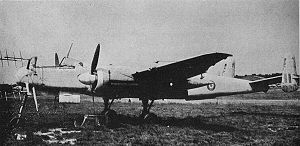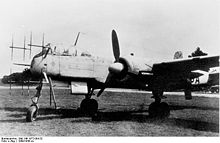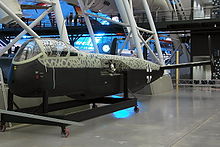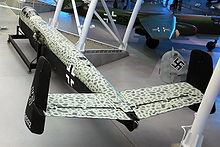Heinkel He 219 Video - Overview
|
|
Heinkel He 219
Heinkel He 219 Uhu

Role: Night fighter
Manufacturer: Heinkel
Designed by: Robert Lusser
First flight: 6 November 1942
Introduced: 1943
Status: Retired
Primary user: Luftwaffe
Number built: ~300
Variants: Hx¼tter Hx¼ 211
The Heinkel He 219 Uhu ("Eagle-Owl") was a night fighter serving with the German Luftwaffe in the later stages of World War II. A relatively sophisticated aircraft, the He 219 possessed a variety of innovations, including an advanced intercept radar. It was also the first operational military aircraft in the world to be equipped with ejection seats, and the first German aircraft with tricycle landing gear. Had the Uhu been available in quantity, it might have had a significant effect upon the strategic bomber offensive of the Royal Air Force, but only 268 were built before the end of the War and they saw only limited service.
Design and development
Due to political rivalries between Josef Kammhuber, commander of the German night fighter forces, Ernst Heinkel, the constructor, and Erhard Milch, responsible for aircraft construction in the Reichsluftfahrtministerium (RLM - the German Aviation Ministry), the development and production of the aircraft was tortuous. The aircraft was also complicated and expensive to construct, a factor that further limited the number of aircraft produced.
When Robert Lusser returned to Heinkel from Messerschmitt, he began work on a new high-speed bomber project called P.1055. This was an advanced design with a pressurized cockpit, twin ejection seats (the first to be planned for use in any combat aircraft), tricycle landing gear featuring a nosegear that rotated its main strut through 90º during retraction, to fit flat within the forward fuselage, and remotely-controlled defensive gun turrets similar to those used by the Messerschmitt Me 210. Power was to be provided by two DB 610 "coupled" engines producing (2,200 kW/2,950 hp) each, delivering excellent performance with a top speed of approximately 750 km/h (470 mph) and a 4,000 km (2,500 mi) range with a 2,000 kg (4,410 lb) bomb load.
The RLM rejected the design in August 1940 as too complex and risky. Lusser quickly offered four versions of the fighter with various wingspans and engines in order to balance the performance and risk. At the same time, he offered the P.1056 dedicated night fighter with four 20 mm cannons in the wings and fuselage. The RLM rejected all of these on the same grounds in 1941. Heinkel was furious and fired Lusser on the spot.
About the same time as Lusser was designing the P.1055, Kammhuber had started looking for a dedicated aircraft for his rapidly-growing night fighter force. Heinkel quickly re-designed P.1055 for this role as the P.1060. This design was similar in layout but somewhat smaller and powered by the smaller and simpler liquid-cooled DB 603 inverted V12 engine, using annular radiators similar to the ones on the Jumo 211-powered Junkers Ju 88A, but considerably more streamlined in appearance. This engine was not known for its altitude performance, which was a problem for this design with its short wings, but Daimler offered a new "G" version that addressed that issue. Heinkel was sure he had a winner and sent the design off to the RLM in January 1942 while he funded the first prototype himself. Nevertheless, the RLM again rejected the He 219 in favour of new Ju 88- and Me 210-based designs.
Construction of the prototype started in February but suffered a serious setback in March, when Daimler said that the DB 603G would not be ready in time. Instead, they would deliver a 603A with a new gear ratio to the props, with the new designation 603C. Even these took until August to arrive, and the prototype did not fly until 6 November 1942. When Kammhuber saw the prototype on the 19th, he was so impressed he immediately ordered it into production over Milch's objections. Milch - who had rejected the He 219 in January - was enraged.
Stability problems were noted, but Heinkel overcame the problem by offering a cash prize to engineers who could fix the problem. Further changes were made to the armament; the dorsal rear defensive guns - mounted atop the fuselage, and firing from a fixed, internal-mount rear facing dorsal "step" position at a point just aft of the wings' trailing edge - were removed due to their ineffectiveness. The forward-firing armament was increased to two 20 mm cannons in the wing roots and four more guns or cannons mounted in the ventral tray.The A-0 model also featured a bulletproof shield that could be raised in the front interior cockpit, hiding the entire bottom portion of windscreen, providing temporary pilot protection, leaving a slot by which the gunsight could be aimed at a bomber and fired. Production prototypes were then ordered as the He 219 A-0 (production prototype aircraft) and quickly progressed to the point where V7, V8 and V9 were handed over to operational units in June 1943 for testing.
Operational history

Picture -
The He 219 had an auspicious combat debut. On the night of 11-12 June 1943, Werner Streib flew the V9 and shot down five bombers between 01:05 and 02:22 hours, before crashing on landing. A claim consistently made is that, "In the next 10 days the three Heinkel He 219A-0 pre-production aircraft would shoot down a total of 20 RAF aircraft, including six of the previously "untouchable" de Havilland Mosquito fighter-bombers. Greatly encouraged, Kammhuber continued to press for immediate production." No record of corresponding Mosquito losses or any documentary evidence exists, however, to suggest that He 219 pilots actually made claims for six Mosquitos during this time.
Production finally got underway with the He 219 A-2 model which included a longer engine nacelle containing an extra fuel tank and typically included the Rx¼stsatz R1 kit with two 30 mm (1.18 in) MK 108 cannons installed as an offensive Schrx¤ge Musik upward-firing system, installed completely within the fuselage. Production problems due to Allied bombing in March meant the A-2/R1 did not reach Luftwaffe units until October 1943. The first 10-15 aircraft were delivered with the 490 MHz UHF-band FuG 212 Lichtenstein C-1 radar sets, complete with their 32-dipole element Matratze antenna array.
Milch repeatedly tried to have the program killed and in the process, Kammhuber was removed from office. Production ceased for a time but was restarted because the new Junkers Ju 388s were taking too long to get into service. Only 206 He 219s had been produced in the previous 15 months. Soon the A-5 began production and was the first major production variant He 219 to enter production. The A-5 featured an updated, 90 MHz VHF-band Telefunken FuG 220 Lichtenstein SN-2 radar system, complete with their larger, draggy Hirschgeweih aerials. It had less range than the C-1, but improved accuracy and resolution and was less vulnerable to chaff jamming.
The He 219 was a capable fighter aircraft, allowing the pilots a large degree of autonomy. Ground control simply got them into the right area and then the pilots took over and hunted down the bombers on their own; the SN-2 radar's 4 km (3 mi) range was greater than the distance between the bombers. While the performance of the A-5 was not extraordinary - approximately 580 km/h (360 mph) speed - it was enough of an advance over the Messerschmitt Bf 110s and Junkers Ju 88Gs to allow the aircraft to chase several bombers in one sortie.
In order to combat the Mosquito, the He 219 had all excess weight removed. With some weapon and radio systems deleted the aircraft was able to attain a speed of 650 km/h (400 mph). This version was given the designation A-6.
The last major production version was the A-7 with improved DB603E engines. The A-7 could be outfitted with two 30 mm (1.18 in) MK 108s in the wing roots, two 30 mm (1.18 in) MK 103 cannons and two 20 mm MG 151/20 cannons in a ventral tray and two 30 mm (1.18 in) MK 108s in a Schrx¤ge Musik installation mid-way down the fuselage, fully contained within it. The relatively long-barreled MK 103s, however were not usually fitted due to weight considerations.
The follow-on series was to be the He 219B fitted with the new, but very troublesome, 1,864 kW (2,500 hp) Junkers Jumo 222A/B 24-cylinder engines, which would have allowed the He 219 to reach 700 km/h (440 mph). They were also to have had increased wing spans of 22.06 m (72.38 ft) for better high-altitude performance. The Jumo 222s did not reach production status however, and only a test machine or two were ever fitted for the engines; some additional airframes with the enlarged wing were slated to fly with high-altitude versions of the DB 603. But again, only one or two test machines ever flew in that configuration.
A further adaptation would have been the He 219C, also intended to use the big wing and Jumo 222 powerplants as well as an all-new fuselage of 17.15 m (56.27 ft) and a complete three-man Ju 388J cockpit section forward and a manned power tail turret aft. Day bomber and night fighter versions were proposed and metal was cut on the project, but without the Jumo engines, they never flew.
Paper projects include the very-high-altitude He 219E with a vastly increased wingspan of 28.5 m (93.5 ft) and DB 614 engines, which were apparently an uprated DB 603G capable of 1,491 kW (2,000 hp).
A more reasonable project was the Hx¼tter Hx¼ 211, a design created by Wolfgang Hx¼tter, that took a standard He 219 fuselage and tail and added a long-span, high aspect ratio wing of 24.55 m (80.54 ft) to create a fast, high-altitude interceptor. Since this design was to be powered by the Jumo 222, it was fated to never fly, although work continued on two sets of wings until they were destroyed by Allied bombing.
The He 219 was the only piston-engined night fighter capable of facing the British Mosquito on equal terms, given its speed, manoeuvrability and fire power, but it never played a significant role in the war because the industry failed to make it available in sufficient numbers.
Variants
He 219 A-0 initially used for pre-production aircraft but became first major production version with 104 built, 1,750 PS DB 603A engines He 219 A-1 Proposed reconnaissance-bomber aircraft. The project was abandoned. He 219 A-2 similar to A-0 but extended engine nacelles with additional fuel tanks, 1,670 PS DB 603AA engines, 85 built He 219 A-2/R1 Two-seat night fighter version, armed with two 30 mm (1.18 in) MK 108 cannons in a ventral tray, two 20 mm MG 151/20 cannons in the wing roots, plus 30 mm (1.18 in) two MK 108s just behind the cockpit. He 219 A-5 planned three-seat night fighter, only some prototypes built from A-2 airframes known He 219 A-6 planned Mosquito-hunter, stripped-down version of the He 219 A-2, armed with four 20 mm MG 151/20s He 219 A-7 Improved night-fighter version, powered by two 1,800 PS DB 603E engines, 210 ordered as of 31 November 1944 He 319 An unbuilt multi-role aircraft project entirely unrelated to the He 219, only having the number sequence in common. He 419 Various derived projects culminating in He 419B-1/R1, six of which were flown; use of the He 319 tail, very long-span wing of 59 square metres (635 sq ft), two 20 mm MG 151/20 in the wings and four 30 mm MK 108 in ventral housing. Speed of 422 mph (679 km/h to 44,619 ft (13600 m)) .
Survivors

Picture - Heinkel He 219 A-2 fuselage preserved at the Steven F. Udvar-Hazy Center
Starting on 16 June 1945, the U.S. Army Air Force Intelligence Service as part of "Operation Lusty" (Luftwaffe Secret TechnologY) took control of three He 219s at Grove in Jutland, Denmark, base of the 1st Night Fighter Wing (Nachtjagdgeschwader 1) when the war ended. These aircraft were made flight-worthy by "Watson's Whizzers" and flown to Cherbourg, France. He 219 A-2 Werknummer 290202, was shipped to the United States with 21 other captured German aircraft on board the British aircraft carrier HMS Reaper and were reassembled at Ford Field, Newark, New Jersey. Werknummer 290202 was given the foreign equipment number FE-614 and later T2-614. It was flown to Freeman Field, Indiana for flight testing along with a second of the three He 219s; a He 219 A-5 prototype, Werknummer 290060 and given the foreign equipment number FE-612. The fate of Werknummer 290060 is unknown. Following testing the He 219 A-2 Werknummer 290202 was then moved in 1946 to Orchard Place Airport in Park Ridge, Illinois. It was stored in a vacant aircraft factory and then transferred to the Smithsonian's National Air Museum on 3 January 1949. Finally the He 219 was crated and shipped to the Smithsonian's Silver Hill, Maryland storage facility in early 1955. He 219 A-2 Werknummer 290202 is undergoing restoration in the collection of the Smithsonian National Air and Space Museum in Washington D.C., USA. Recently the fuselage has been put on display at the Steven F. Udvar-Hazy Center by Dulles Airport, however the wings are still being restored at the Paul Garber Facility in Suitland, Maryland. Today the fuselage can be seen displayed near the museum's Dornier Do 335 and Arado Ar 234, aircraft that accompanied it across the Atlantic over 60 years ago.

Picture - Heinkel He 219 A-2 fuselage preserved at the Steven F. Udvar-Hazy Center
Specifications (He 219 A-7)
Data from Jane's Fighting Aircraft of World War II
General characteristics
Crew: 2
Length: 15.5 m (51 ft 0 in)
Wingspan: 18.5 m (60 ft 8 in)
Height: 4.4 m (14 ft 5 in)
Wing area: 44.4 m² (478 ft²)
Max takeoff weight: 13,580 kg (29,900 lb)
Powerplant: 2x Daimler-Benz DB 603E liquid-cooled inverted V12 engine, 1,800 PS (1,324 kW) each
Propellers: VDM three blade constant speed airscrew
Performance
Maximum speed: 616 km/h (333 kn, 385 mph)
Range: 1,540 km (831 nmi, 960 mi)
Ferry range: 2,148 km (1,160 nmi, 1,335 mi)
Service ceiling: 9,300 m (30,500 ft)
Armament
Guns:
up to 4 x 20 mm MG 151 cannons in a detachable fairing under the fuselage, 300 rpg
2 x 20 mm MG 151s in wing roots, 300 rpg
2 x 30 mm (1.18 in) MK 108 cannons, Schrx¤ge Musik (oriented 65° above horizontal), 100 rpg
Comparable aircraft
de Havilland Mosquito NF
Focke-Wulf Ta 154
Messerschmitt Bf 110
Nakajima J1N Gekko
P-61 Black Widow - the only Allied dedicated night fighter to see service.
Related lists
List of military aircraft of Germany
Bibliography
Boyne, Walter J. Clash of Wings. New York: Simon & Schuster, 1994. ISBN 0-684-83915-6.
Bridgeman, Leonard (editor). âHeinkel He 219.â Janeâs Fighting Aircraft of World War II. London: Studio, 1946. ISBN 1-85170-493-0.
Chorley, W.R. Royal Air Force Bomber Command Losses of the Second World War, Volume 5 1944 - amendments and additions, Volume 6 1945 - amendments and additions. London: Ian Allen Publishing, 1997. ISBN 978-0904597912.
Chorley, W.R. Royal Air Force Bomber Command Losses of the Second World War, Volume 6 1945 - amendments and additions. London: Ian Allen Publishing, 2004. ISBN 978-0904597929.
Franks, Norman L.R. Royal Air Force Fighter Command Losses of the Second World War: Volume 3. Operational Losses: Aircraft and Crews 1944-1945 (Incorporating Air Defence Great Britain and 2nd TAF): 1944-1945. Hersham, Surrey, UK: Midland Publishing, 2000. ISBN 978-1857800937.
Green, William. Warplanes of the Third Reich. London: Macdonald and Jane's Publishers Ltd., 1970 (fourth Impression 1979). ISBN 0-356-02382-6.
Green, William and Gordon Swanborough. "Heinkel's Nocturnal Predator... The He 219". Air Enthusiast. Issue Forty, September-December 1989. Bromley, Kent:Tri-Service Press. pp. 8-19, 70-72.
Greenhous, Brereton. The Crucible of War: 1939-1945. Toronto: University of Toronto Press, 1994. ISBN 0-80200-574-8.
Kay, Anthony and John Richard Smith. German Aircraft of the Second World War: Including Helicopters and Missiles (Putnam's History of Aircraft). London: Putnam, 2002. ISBN 0-85177-920-4.
Nowarra, Heinz J. Heinkel He 219 "Uhu". Atglen, PA: Schiffer Publishing Inc., 1989. ISBN 0-8874-0188-0.
Remp, Roland. Heinkel He 219: An Illustrated History Of Germany's Premier Nightfighter. Atglen, PA: Schiffer Publishing Inc., 2007. ISBN 0-7643-1229-4.
Smith, J.R. and Antony L. Kay. German Aircraft of the Second World War. London: Putnam, 1972. ISBN 1-85177-836-4.
Heinkel He 219 Pictures and Heinkel He 219 for Sale.
Living Warbirds: The best warbirds DVD series.
Source: WikiPedia